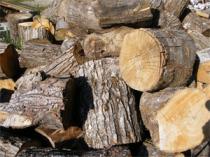
UNIVERSITY PARK – At today’s fuel prices, burning wood remains a wise and viable option to reduce home-heating bills, according to a forest resources expert in Penn State’s College of Agricultural Sciences.
“Burning firewood for heat is environmentally friendly and economically smart,” said Michael Jacobson, extension specialist and associate professor of forest resources, who focuses on socio-economic and policy issues related to forest land. “Unlike coal, oil and gas, which are nonrenewable fossil fuels that contribute greenhouse gas emissions, wood — if sustainably harvested — is a local and renewable energy resource.”
Pennsylvania forests are dominated by high-density hardwood species, which are among the best-burning firewood available, Jacobson noted. Denser woods weigh up to 3 tons per cord, while the lighter woods are 1.5 to 2 tons per cord. Beech, birch, some maples, hickory and oak are among the most common species in Pennsylvania, and also among the densest.
“Pound per pound, softwoods have more heat value; however, softwood has half the heating value per unit volume of these hardwoods,” he explained. “In the East, consumers prefer hardwood species for firewood because they offer more heat per volume, and when dry, they are less likely to result in creosote build-up problems.
“Firewood is best for burning when it has 20 percent or less moisture content, which takes a year or more of drying under roof and off the ground.”
The moisture content for wood varies, Jacobson pointed out. Green (wet) wood can have a moisture content of well over 50 percent. Green wood can contain more weight in water than it does weight in wood, depending on the species. Air-seasoned wood, by contrast, is 20 to 25 percent moisture, and wood for furniture is four to six percent.
“Burning unseasoned wood wastes energy as the moisture has to be driven off before combustion can occur,” Jacobson said. “Split wood dries out faster.”
He advises consumers to consider three things when buying firewood: price, quantity and quality. Firewood prices differ across regions and generally are higher in urban areas more distant from the woods. Prices in central Pennsylvania this fall have been hovering around $150 per cord.
“Normally, these prices are for wood delivered to the house, but check to see if there is an additional transportation cost,” Jacobson said. “Find out whether it will be stacked or just dumped in a pile, and if the wood is split and cut to length to fit your heating appliance.
“The firewood market is fairly robust these days,” he added. “My local newspaper today has six vendors selling firewood. This is an industry that provides part-time work and extra cash for families this time of the year. Many landowners also enjoy cutting firewood for their own use. Wintertime is fast approaching, which means acquiring firewood and stoking the fire.”
Jacobson offered a word of caution about the wood you buy or transport for your heating needs, noting that much of Pennsylvania is under quarantine for the emerald ash borer, an insect that threatens ash trees. If you buy or collect your own firewood, don’t move it outside of the local region, he warned. Burn it close to its source — doing this will help protect our forests against invasive pests.
How much money will burning wood save you? One way to measure this is to look at the equivalent prices per heating unit for alternative fuels. With firewood at $150 per cord, heating oil going for about $3 gallon, and natural gas over $1 per thermal unit, burning word is the wise choice because it is less expensive.
“Coal is still the most cost-efficient heating fuel, with wood a close second,” Jacobson said. “But before you buy firewood, check that you are getting a cord worth of wood, make sure it is dry, is high-quality hardwood cut to your needs and is stacked upon delivery. It will make for a happier and warmer winter.”
Jeff Mulhollem, Penn State University